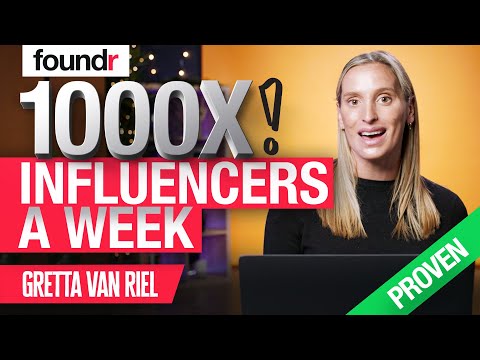Foundr Magazine publishes in-depth interviews with the world’s greatest entrepreneurs. Our articles highlight key takeaways from each month’s issue. We talked with Raina Penchansky, the co-founder and CEO of Digital Brand Architects (DBA) and co-founder of Dear Media, about how to make influencer partnerships that move your business forward. To read more, subscribe to the magazine.
—————
Where are you at with influencers?
Maybe you’ve dabbled with them in a marketing campaign or partnered with a few for a product launch. Or perhaps you’re just starting a business and unsure if working with influencers is worth it.
If you’re cautious about the state of influencer marketing, then you’re not alone. It’s a question we constantly get from the Foundr community, and for good reason.
The influencer marketing industry will reach $21.1 billion this year, according to Influencer Marketing Hub. That’s a $19.4 billion increase compared to 2016. And in 2021, IZEA Insights reported that the average cost of a paid Instagram post was $1,170.
So are influencers worth the cost?
To answer that trending question, we brought in an expert. Raina Penchansky is the co-founder and CEO of Digital Brand Architects (DBA) and co-founder of Dear Media. She’s nurtured 140 prominent social media influencers, including Olivia Ponton, Patrick Starrr, Aimee Song, and Clea Shearer and Joanna Teplin of The Home Edit.
If you have questions about working with influencers and creators or want to build a business around your brand, Penchansky’s answers are for you.
How Do I Monetize My Content?
A report conducted by Linktree last year revealed that 200 million people consider themselves creators. A creator makes content for the internet (video, podcasts, articles, photos, or social media posts) and earns income through an audience, platform, or both.
While the terms influencers and content creators are often used synonymously, creators tend to output entertainment content versus showcasing their lifestyle through social media.
If you’re a traditional influencer, then you can make money by:
- Sponsored posts
- Paid partnerships
- Event attendance/coverage
- Selling a partner’s products
- Selling your own products
If you’re a creator (think YouTube, livestreaming, podcasting, or writing), you might monetize your branded content in any or all of these ways:
- Audience donations
- Subscriptions
- Merchandise
- Licensing
- Advertising
- Platform views payback
- Creator fund
Ultimately, it doesn’t really matter if you label yourself as an influencer or creator. If you’ve cultivated a following on the internet, you probably want to monetize all that effort you’re putting into your videos, posts, streams, and stories.
But before you start a Patreon or create merchandise, Penchansky suggests thinking long-term about what you want your business or brand to look like in five years.
“Obviously, you need the passion, but you also have to figure out what the business element of it is,” Penchansky says.
“What [are you] building and what [are you] trying to grow, and what are [your] goals?”
Penchansky is aware that many of the products influencers sell or promote don’t actually satisfy a need. But she says people love to consume, and that’s why products sell.
“We love marketing, we love trends, we love pop culture, we love all the things that sort of encompass a brand,” Penchansky says. “And [if you’re] starting a company, you have to really figure out the why and ultimately how are you monetizing and to what degree.”
If you want to turn your content hobby into a career, remember that your audience won’t buy your products. They’ll be buying you.
Don’t Skip: Influencer Marketing 101
What Type of Influencers Should I Work With?
Penchansky says influencer partnerships have grown so much that there are layers upon layers of types of people to work with.
If you want to work with influencers, there is a general hierarchy of reach paired with a financial cost:
- Traditional Celebrities: Hollywood stars, musicians, and politicians
- Macroinfluencers: The highest cost to work with and the widest reach and audience
- Influencers: Full-time or rising star influencers, typically with powerful voices in a niche or industry
- Microinfluencers: The cheapest to work with and the narrowest niche, could be a popular account in a mid-sized city or a trusted voice in a niche
- Nanoinfluencers: An everyday person with a consistent social media presence or a content theme
Numbers aside, how do you decide who to work with? Penchansky believes it’s all about their point of view.
“Their point of view, their understanding of their audience, their engagement, and what it is that they want to do in the space,” Penchansky says.
Understanding an influencer’s point of view will require you to do a bit of homework and have a conversation. Emailing or DMing an influencer is the beginning stage of a partnership that could last for years.
Penchansky knows the growing pains of business partnerships. She’s watched deals slowly degrade between influencers and brands. That’s why she suggests considering those potential challenges before you start working with an influencer.
“Every partnership starts the same: fantastic in the beginning, and then you hit some rocky patches,” Penchansky says. “Know that you are on the same page from a values point of view to get through them.”
So don’t worry about budgets, followers, and photo angles. Spend time getting to know an influencer and understanding their point of view. The way they see the world should be the same as your customers.
What If I Have a Small Budget?
Gone are the days when you could send free products to an influencer and cross your fingers that they’d like them enough to post.
Today, it will cost you.
Penchansky says you should treat influencer partnerships like any other business partnership.
“Most businesses starting out aren’t going to have a huge budget. So you just have to be incredibly thoughtful and try to find a genuine connection,” Penchansky says. “And I do think that TikTok and Instagram are still places where you can find that genuine connection and find people who are going to really help in the process.”
Throughout the past decade of working with influencers, Penchansky’s witnessed thriving partnerships even if the budgets started small.
“The space, by its nature—especially [for] women in this space—wants to lift other creators up and wants to lift small businesses up.”
If you’re approaching an influencer in person or through DM, Penchansky advises you to find the personal connection between your brand and the influencer. And it’s OK to be transparent about your budget or lack thereof.
“You have to come from a place of understanding their value, understanding what you can bring to them, how you can have a symbiotic relationship, and how you can appeal to them,” Penchansky says. “It’s just about finding people who speak to your audience.”
Your budget might not be impressive, but your pitch to an influencer could transform into something better.
What If I’m Out of Content Ideas?
Penchansky shares a familiar story among brands, influencers, and creators:
You get awareness for something.
You double down on that something.
Eventually, you and your audience get tired of that something.
She calls it the “bad loop” of content creation.
“Content sort of follows the same things that life does or that any good conversation or any good friendship or any good movie does, which is, ‘how am I evolving this?’”
Whether your influencer partnership has grown stale or your best-selling product sales are dipping, Penchansky believes it’s the result of playing it safe.
“You cannot be afraid to pivot and to fail a little bit and not have it do well. You’ve got to find your way,” Penchansky says.
Because of the rise of entertainment content through short-form videos on TikTok and Instagram Reels, every audience expects entertainment.
But are you entertained?
Penchansky says your audience will immediately swipe if you’re not bringing joy to your content and influencer partnership.
“If you are not feeling it, trust me, your audience is picking up on that,” Penchansky says. “What got you there in the first place is that you were doing something that you enjoyed and that did feel authentic and realistic and fun.”
If you’re not feeling it, then pause. Remember why you started and try to rediscover that energy because your audience can feel it.
Keep Learning: What Is Predictive Analytics and How Can It Support Influencer Marketing?
What’s the Future of Influencer Partnerships?
There’s no going back. Penchansky says kids nowadays dream of being an influencer over a pop star. If you’re a founder, you’ll have to face the reality of being tied to social media success.
“Everyone in some way, shape, or form, whether you are a brand or a person or a personality or a pet, you have a social platform,” Penchansky says. “Brands need to be diversified.”
To diversify your business and brand, she says to think beyond the face value of what an influencer offers.
“For instance, there’s an incredible food influencer who we work with, but she has insanely high conversions [in fashion],” Penchansky says. “And so it’s really starting to get into the sort of metadata around like who the creator is that you’re working with, what their audience wants, [and] how do you engage with them?”
Penchansky believes influencer marketing is at its infancy stage, and budgets will only increase over time. She says if you can invest in long-term partnerships with up-and-coming influencers in your niche and develop out-of-the-box content ideas, you’ll already be ahead of the big businesses that just pay for follower count.
“[Social media is] where the eyeballs are, and it’s going to be a race to figure out how to get someone’s attention and then the sort of layers of that attention,” Penchansky says.
The race is on. It’s time for you to find an influencer who shares your point of view.
The post How to Make Influencer Partnerships Last from an Agency Pro appeared first on Foundr.




